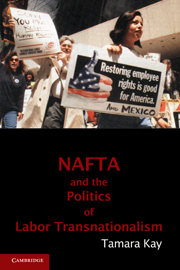Book contents
- Frontmatter
- Contents
- List of Tables
- List of Figures
- Preface
- Acknowledgments
- List of Abbreviations
- 1 Introduction
- PART ONE THE EMERGENCE OF TRANSNATIONALISM
- 2 Labor Nationalism
- 3 NAFTA as Catalyst
- 4 Constituting Transnational Labor Rights
- 5 Seizing the Opportunity NAFTA Provided
- PART TWO VARIATIONS IN TRANSNATIONALISM
- PART THREE CONCLUSIONS
- Appendix
- Bibliography
- Index
4 - Constituting Transnational Labor Rights
Published online by Cambridge University Press: 05 June 2012
- Frontmatter
- Contents
- List of Tables
- List of Figures
- Preface
- Acknowledgments
- List of Abbreviations
- 1 Introduction
- PART ONE THE EMERGENCE OF TRANSNATIONALISM
- 2 Labor Nationalism
- 3 NAFTA as Catalyst
- 4 Constituting Transnational Labor Rights
- 5 Seizing the Opportunity NAFTA Provided
- PART TWO VARIATIONS IN TRANSNATIONALISM
- PART THREE CONCLUSIONS
- Appendix
- Bibliography
- Index
Summary
The struggle over fast-track began a process of constituting transnational actors and interests as labor activists came together in the transnational trade-negotiating field. The process intensified as they mobilized to demand stronger labor protections in the side agreement. In an ironic twist, however, activists' ceaseless efforts to link free trade to labor protections directly resulted in the negotiation and passage of a historic labor side agreement, the North American Agreement on Labor Cooperation (NAALC), which they then vigorously denounced. And in another unintended twist, whereas labor leaders in all three NAFTA countries predicted it would do little to promote labor rights in North America, the NAALC did have one unexpected outcome – it stimulated and facilitated relationships among unions that then organized to collectively demand stronger labor rights protections in North America (including strengthening the NAALC itself).
This chapter explores how, by creating a new transnational legal field, the NAALC helped generate labor transnationalism in two ways. First, it defined and codified transnational labor rights by establishing eleven North American labor principles and recognizing labor unions' right of standing through a complaint submission process. In so doing, the NAALC created a North American labor rights regime based on a set of rights that all three NAFTA nations agreed to protect. The creation of this regime provided a foundation for labor transnationalism; by granting legitimacy to North American labor unions and their grievances and enabling them to see their grievances as inextricably linked, it helped constitute them as transnational actors with transnational interests.
- Type
- Chapter
- Information
- NAFTA and the Politics of Labor Transnationalism , pp. 100 - 169Publisher: Cambridge University PressPrint publication year: 2011



